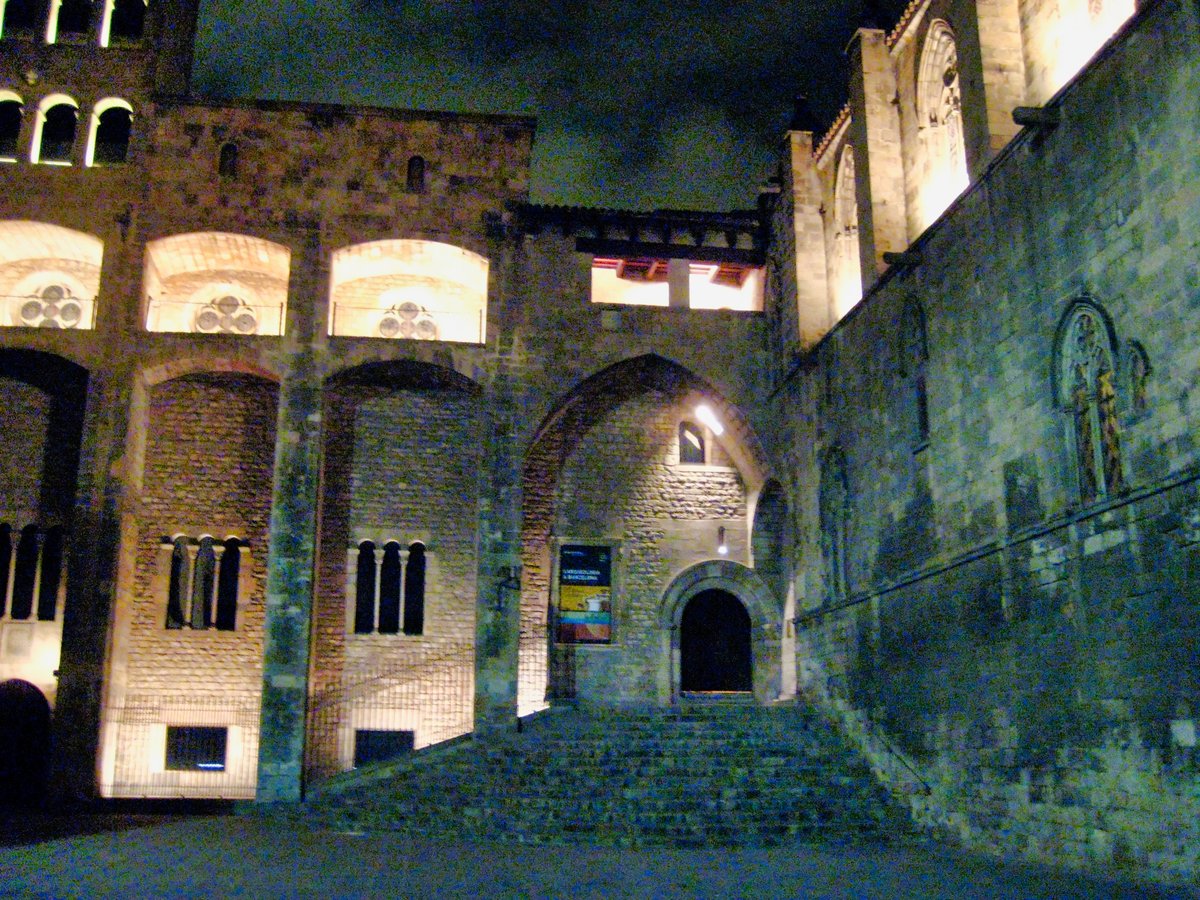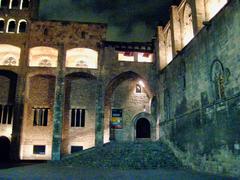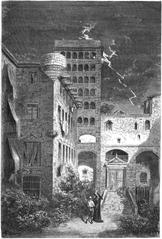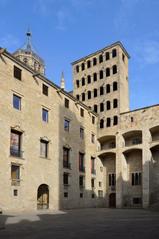
Palau Reial Major Visiting Hours, Tickets, and Historical Guide – Barcelona
Date: 14/06/2025
Introduction: The Heart of Medieval Barcelona
Nestled in the vibrant Gothic Quarter, the Palau Reial Major stands as one of Barcelona’s most significant historical sites. Originally built in the 11th century as the residence of the Counts of Barcelona, this grand palace complex evolved into the political and cultural hub of the Crown of Aragon, bearing witness to landmark events such as Christopher Columbus’ audience with King Ferdinand II and Queen Isabella I in 1493. Today, the Palau Reial Major invites visitors on an immersive journey through Catalonia’s layered history, where Romanesque foundations meet Catalan Gothic grandeur, and Renaissance influences are found throughout. Integrated into the Museu d’Història de Barcelona (MUHBA), it offers access to royal halls, archaeological remains, and a dynamic calendar of events, making it a must-visit for history enthusiasts and curious travelers alike.
This comprehensive guide provides up-to-date visiting hours, ticket options, accessibility details, and practical travel tips—ensuring your visit to this emblematic landmark is both enriching and well-organized. For the latest official information, refer to the MUHBA Palau Reial Major official website and Barcelona Turisme.
Historical Overview
Origins and Early Development
Built atop ancient Roman city walls, the Palau Reial Major’s earliest structures date from the 11th century, originally serving as the residence of the Counts of Barcelona. Its foundations incorporate elements from Visigothic and Romanesque periods, revealing the site’s deep historical roots (Barcelona Turisme). The palace began as both a defensive stronghold and an administrative center.
Medieval Expansion and Gothic Flourish
During the 13th to 15th centuries, the palace underwent significant expansion, mirroring the rise of the Crown of Aragon. This era saw the construction of grand ceremonial spaces in the Catalan Gothic style, such as the Saló del Tinell, and the addition of key structures like the Chapel of Santa Àgata and the Mirador del Rei Martí watchtower (Spain.info; IR Barcelona).
Architectural Highlights
- Saló del Tinell: A monumental hall with vast semicircular arches and medieval murals, used for royal ceremonies.
- Chapel of Santa Àgata: Built in 1302, this Gothic chapel features the renowned altarpiece by Jaume Huguet.
- Palau del Lloctinent: A 16th-century structure blending Gothic and Renaissance styles, now home to the Archive of the Crown of Aragon.
- Mirador del Rei Martí: A 14th-century watchtower offering panoramic views over the city (Barcelona Yellow).
Political and Cultural Significance
The palace was the political heart of medieval Catalonia, hosting royal audiences and key historical events, including the reception of Christopher Columbus by the Catholic Monarchs in 1493 (Explorial).
Later Transformations and Preservation
Though its political role waned after the 15th century, 20th-century archaeological excavations and the relocation of Casa Clariana-Padellàs revitalized the complex. The site became a central venue of the Museu d’Història de Barcelona (MUHBA), allowing visitors to explore Roman and medieval remains beneath the palace (Barcelona Turisme).
Visiting Palau Reial Major
Location and Access
Address: Plaça del Rei, 08002 Barcelona, Spain
The palace is centrally located and easily accessible via Metro (Jaume I, Line 4), several city bus routes, and is a short walk from La Rambla (Nomadic Matt).
Opening Hours
- Tuesday to Sunday: 10:00 AM – 7:00 PM
- Closed on Mondays (except public holidays)
- Last admission: 6:30 PM
- Seasonal Variations: Hours may extend during summer months (June–September). Always check the MUHBA website for updates.
Tickets and Prices
- General Admission: €7 (€7.50 for some exhibitions)
- Discounts: For students, seniors, groups, and EU residents under 25
- Children under 16: Free
- Free Entry: Every Sunday after 3:00 PM and on the first Sunday of each month (Nomadic Matt; Barcelona Turisme)
- Where to Buy: Online via the MUHBA booking portal or onsite (advance booking recommended for peak periods).
Facilities and Accessibility
- Restrooms, Cloakroom, Gift Shop: Available within the complex.
- Wheelchair Access: Main exhibition areas and Roman ruins are accessible via ramps and elevators. Some sections may have limited access due to the historic structure. Staff assistance is available (MUHBA accessibility).
- Audio Guides: Available in several languages.
- Guided Tours: Offered in Catalan, Spanish, English, and sign language. Advance booking is advised.
What to See and Do
Architectural and Artistic Highlights
- Saló del Tinell: Experience the vast Gothic hall used for royal ceremonies and events.
- Chapel of Santa Àgata: Admire Jaume Huguet’s 15th-century altarpiece, a masterpiece of Catalan Gothic painting.
- Mirador del Rei Martí: Climb the watchtower for unique views over the Gothic Quarter.
- Palau del Lloctinent: Explore Renaissance and late Gothic architecture.
Museum Exhibits
- Medieval and Renaissance Collections: Artifacts, documents, and multimedia displays illustrating Barcelona’s history.
- Royal Apartments: Explore restored rooms and period furnishings.
- Roman Ruins: Discover 4,000 square meters of subterranean Roman remains, including ancient streets and baths (Nomadic Matt).
Special Events and Cultural Programs
The palace regularly hosts exhibitions, concerts, and cultural events. Check the MUHBA events calendar for updates.
Visitor Tips
- Best Times to Visit: Early mornings or late afternoons are quieter; weekdays outside peak season (spring/autumn) offer the best experience.
- Photography: Permitted in most areas without flash or tripods. Always check signage.
- Duration: Allow at least 1.5–2 hours to explore the palace and museum.
- Security: Remain vigilant with personal belongings in crowded areas.
Nearby Attractions
- Barcelona Cathedral: A short walk away; an impressive example of Gothic architecture.
- Plaça Sant Jaume: Home to the City Hall and Palau de la Generalitat.
- Museu Picasso: One of the world’s finest collections of Picasso’s works.
- La Rambla: Barcelona’s iconic boulevard for strolling and people-watching (Nomadic Matt).
Numerous restaurants and shops are scattered throughout the area, offering local cuisine and souvenirs.
Sustainability and Responsible Tourism
Barcelona encourages responsible tourism to preserve its historical sites.
- Respect the site and artifacts.
- Support local businesses.
- Visit during off-peak times to reduce crowding (Nomadic Matt).
Frequently Asked Questions (FAQ)
Q: What are the Palau Reial Major visiting hours?
A: Tuesday to Sunday, 10:00 AM – 7:00 PM; closed Mondays except public holidays.
Q: How much do Palau Reial Major tickets cost?
A: General admission is €7; free entry is available every Sunday after 3:00 PM and on the first Sunday of each month.
Q: Is the site accessible for wheelchair users?
A: Yes, main exhibition areas and Roman ruins are accessible via ramps/elevators. Assistance is available on request.
Q: Are guided tours available?
A: Guided tours are offered in multiple languages; advance booking is recommended.
Q: Can I take photos inside?
A: Yes, photography is allowed in most areas (without flash/tripods).
Contact & Visitor Information
- Address: Plaça del Rei, 08002 Barcelona, Spain
- Phone: +34 932 563 100
- Official Website: MUHBA Palau Reial Major
For the latest updates on opening hours, ticket prices, and exhibitions, consult the official MUHBA website.
Enhance Your Visit
- Download the Audiala app for guided tours and up-to-date visitor info.
- Follow us on social media for the latest cultural and travel updates.
Summary & Visitor Recommendations
The Palau Reial Major is a cornerstone of Barcelona’s historical and cultural identity. From the commanding arches of the Saló del Tinell to the exquisite altarpiece in the Chapel of Santa Àgata and the panoramic vistas from the Mirador del Rei Martí, the site encapsulates the grandeur of Catalonia’s past. With accessible facilities, multilingual tours, flexible ticketing (including free entry periods), and a central Gothic Quarter location, the Palau Reial Major is an ideal starting point for exploring the city’s medieval heart.
To make the most of your visit, check the latest details on the official MUHBA website, consider booking in advance, and use audio guides or guided tours for a deeper understanding of the palace’s history and significance.
Reliable Sources and Further Reading
- Barcelona Turisme: Palau Reial Major
- MUHBA Official Site: Palau Reial Major
- Nomadic Matt: Barcelona Itinerary
- Barcelona Tourism: Palau Reial Major
































































